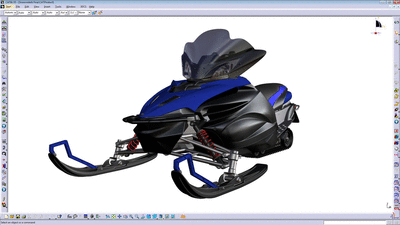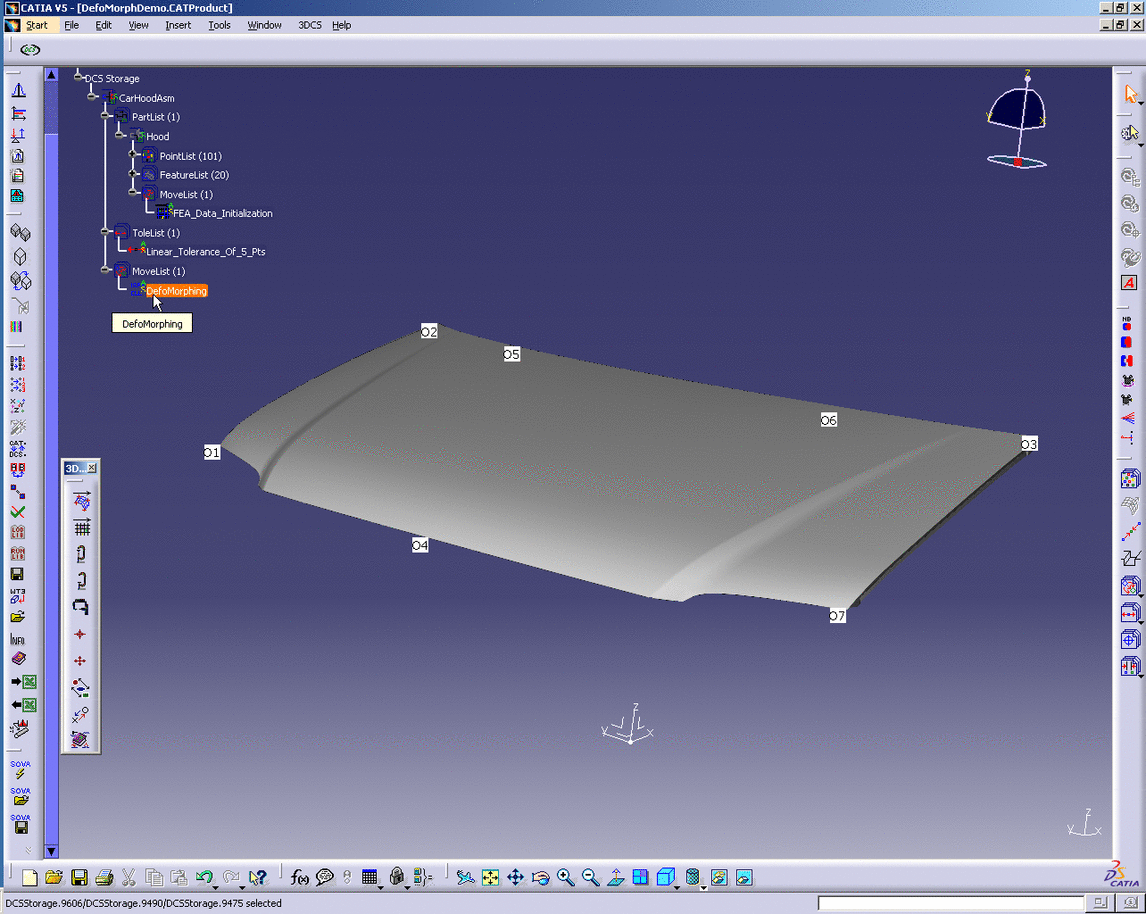+91 98811 44511
3DCS - DIMENSIONAL VARIATION ANALYSIS
3DCS Variation Analyst - Core Module

3DCS Variation Analyst for CATIA
3DCS Variation Analyst for CATIA (V5/ V6/ 3DEXPERIENCE Based) is an integrated software solution in CATIA that simulates product assembly and part tolerance 3D stack-ups through Monte Carlo Analysis, Equation-Based, and High-Low-Median (Sensitivity) Analysis.
Using the integration designers can seamlessly transfer the model built in CATIA V5 or V6 or 3DEXPERIENCE into 3DCS and analyze it for variation without any loss of data.
The integration with FTA module in CATIA allows seamless transfer of GD&T information into 3DCS saving time to annotate again.
Any changes made in the original model and the FTA information immediately reflects in 3DCS to re-run the analysis saving time in running iterations and 'what-if' scenarios.
Interested in a demo or want to know more?

3DCS Variation Analyst for NX
3DCS Variation Analyst for NX is an integrated software solution in Siemens NX CAD that simulates product assembly and part tolerance 3D stack-ups through Monte Carlo Analysis and High-Low-Mean (Sensitivity) Analysis.
Using the integration designers can seamlessly transfer the model built in NX v9/10/11/12 or NX Continuous into 3DCS and analyze it for variation without any loss of data.
The integration with PMI module in NX allows seamless transfer of GD&T information into 3DCS saving time to annotate again.
Any changes made in the original model and the PMI information immediately reflects in 3DCS to re-run the analysis saving time in running iterations and 'what-if' scenarios.
3DCS is also integrated into Siemens Teamcenter PLM.
Interested in a demo or want to know more?

3DCS Variation Analyst for CREO
3DCS Variation Analyst for CREO is an integrated software solution in PTC CREO that simulates product assembly and part tolerance 3D stack-ups through Monte Carlo Analysis, Equation-Based, and High-Low-Median (Sensitivity) Analysis.
Using the integration designers can seamlessly transfer the model built in CREO into 3DCS and analyze it for variation without any loss of data.
The integration with Annotations module in CREO allows seamless transfer of GD&T information into 3DCS saving time to annotate again.
Any changes made in the original model and the Annotations information immediately reflects in 3DCS to re-run the analysis saving time in running iterations and 'what-if' scenarios.
Interested in a demo or want to know more?

3DCS Variation Analyst for SOLIDWORKS
3DCS Variation Analyst for SOLIDWORKS is an integrated software solution in SOLIDWORKS that simulates product assembly and part tolerance 3D stack-ups through Monte Carlo Analysis, Equation-Based, and High-Low-Median (Sensitivity) Analysis.
Using the integration designers can seamlessly transfer the model built in SOLIDWORKS into 3DCS and analyze it for variation without any loss of data.
The integration with FTA module in SOLIDWORKS allows seamless transfer of GD&T information into 3DCS saving time to annotate again.
Any changes made in the original model and the FTA information immediately reflects in 3DCS to re-run the analysis saving time in running iterations and 'what-if' scenarios.
Interested in a demo or want to know more?

3DCS Variation Analyst - MultiCAD (CAD Neutral)
3DCS Variation Analyst Multi-CAD is a stand-alone tolerance analysis software solution that simulates product assembly and part tolerance 3D stack-ups through Monte Carlo Analysis and High-Low-Median (Sensitivity) Analysis.
CAD Neutral Tolerance Simulation
Work With Any CAD System including CATIA, NX, CREO, SOLIDWORKS as well as other systems like SolidEdge, Autodesk Inventor.
3DCS Multi-CAD works with native CAD files (.prt, CADproduct, etc), STEP, IGES and JT files. This provides a single platform that can include products designed in many different CAD systems.
3DCS Multi-CAD saves on licensing costs for companies using multiple CAD systems while offering the flexibility of being CAD neutral. This can be particularly useful for Engineering Services Providing companies who have to use different CAD systems as per their customer's platform of choice.
Interested in a demo or want to know more?

3DCS Mechanical Variation Modeler
3DCS Mechanical Variation Modeler is a standalone or CAD integrated platform, designed as a less complex tool compared to 3DCS Variation Analyst, focused on mechanical joints and constraints to make modeling more intuitive for mechanical assemblies. MVM is integrated into CATIA V5, NX, 3DEXPERIENCE, CREO, and SOLIDWORKS and stand-alone Multi-CAD.
3DCS Mechanical Variation Modeler is built on the 3DCS platform incorporating 3DCS Mechanical Modeler into its base functionality to model complicated linkages and mechanical assemblies with easy to apply Moves, Joints, and Constraints.
3DCS Mechanical Variation Analyst uses Monte Carlo Simulation & Sensitivity Analysis.
Value:
-
Create and start analyzing faster with embedded GD&T (PMI)
-
Read in Joints and Constraints to assemble the product
-
Determine which areas are critical to your build quality to focus on and measure
-
Save money by loosening non-critical tolerances (and make your suppliers happy)
Interested in a demo or want to know more?
3DCS Add On Modules

3DCS FEA Compliant Modeler
Bring Finite Element Analysis into your tolerance analysis system to account for flexible materials, parts, heat, force, and gravity
Traditional variation analysis methods are considered to be "rigid-body" or "non-compliant" modeling; meaning, that every part within the assembly does not flex or would not be distorted through an assembly process such as welding, clamping or unclamping of an assembly fixture.
While this might be the case with a few machined components, most commodities and materials like sheet metal, plastics, aluminum, etc. can be heavily influenced through the manufacturing processes (both fabrication and assembly), thus changing the dimensional integrity or shape of the part/assembly. Finite Element Analysis (FEA) is used to determine the stresses and displacements in mechanical objects and systems, and is the basis for this leading edge advancement in predictive analysis.
3DCS FEA Compliant Modeler, an add-on module to the 3DCS software solutions, utilizes FEA methods to accurately simulate variation of compliant parts and assemblies within the 3D Variation Analysis model.
Interested in a demo or want to know more?

3DCS Mechanical Modeler
Not all parts and assemblies are static. Many products move, react and change during their operation, whether a robotic arm, the shocks of an automobile, the landing gear of a plane or the pistons in an engine. Variation can affect these kinds of assemblies throughout their operation.
Using a new set of kinematic Joints and Constraints and unique simulation, 3DCS Mechanical Modeler can determine the impact of variation on your assembly through its entire range of motion.
With built-in tools like the Degree of Freedom counter, 3DCS Mechanical Modeler allows users to tackle a whole new breadth of models and applications.
3DCS Mechanical Modeler is an add-on module for 3DCS software solutions, available in all versions, and adding a new toolbar containing Joints and Constraints, Mechanical Moves, Deviation in Motion and the Degree of Freedom counter.
Interested in a demo or want to know more?

Advanced Analyzer & Optimizer
Use Advanced Analyzers to work with large models, validate moves, determine which part contributes the most variation and optimize tolerances based on set goals
This module offers
Six Tolerance Analysis Tools in One
2. Critical Tolerance Identifier
3. Tolerance Optimizer
4. Locator Sensitivity Analyzer
5. Simulation-Based Sensitivity
Using AAO you can:
-
Large models with a lot of measurements or tolerances
-
Which part in the assembly is causing the most variation?
-
Non-linear relationships in your model
-
Optimize your tolerances quickly
-
Which measurements should be measured in production
-
Check your locators or test different locating strategies
-
What If studies on different tolerances across the model
-
Optimize sequences of operations - welds, bolts, rivets, clamps
Interested in a demo or want to know more?

Geo Factor Analyzer
3DCS software provides GeoFactor analysis as one of its analysis methods to determine the sensitivity of tolerances. This geometric relationship is displayed as a factor, called a GeoFactor, which is a multiplier to the tolerance based on its influence in the overall assembly.
GeoFactor improves your analysis results to help you understand how the geometry of your assembly affects your tolerances. This is important when optimizing tolerances and understanding which tolerances are critical to your quality. Find out how to use GeoFactor to better understand your model's quality.
Benefits:
-
GeoFactor greater than one amplifies a tolerance
-
GeoFactor less than one mitigates a tolerance
-
One part of the HLM Sensitivity results
View all GeoFactor values in your model in one window. Update your model information and see the effects instantly.
Interested in a demo or want to know more?

Visualization Export
Perceived Quality is the quality attributed to a product based on its perceptual experience. This incorporates the experience a customer has with a product and how it makes them feel about that product.
Bringing together the shape, the appearance, the texture, and physical feel of the product as well as the emotional experience of using the product, Perceived Quality directly affects the opinion of the value of the product. This perceived value then drives the business forward.
Visualization Export gives engineers the ability to view simulations of their final product's variation to make decisions about design early in the Product Life Cycle that will ultimately affect their customers' Perceived Quality of the product.
Steps in a Perceived Quality driven PLM Cycle:
-
Design Spec Studies and Visualization
-
Review Specifications (ex. Gap and Flush) and Determine Objectives
-
Create Tolerance Analysis Models and run Monte Carlo Simulations
-
Share and Approve/Reject Results
Interested in a demo or want to know more?

Dimensional Engg Services
Scope:
-
Variation Simulation Modeling: Three-dimensional tolerance analysis aids in developing robust designs that minimize dimensional variation. When used for defining and managing products functional tolerancing and coordinating their measurement data, 3D tolerance analysis significantly reduces the rework required for engineering drawings, tools and gages.
-
Current production troubleshooting: Identifying specific contributors, either from the product or the process, and rank critical components tolerances contribution & impact on the total cumulative variation, enhancing product quality while lowering costs.
Type of Services:
-
GD&T Training (Basic)
-
GD&T Training (Advanced)
-
Stack Up Analysis Training
-
3DCS Software Training
-
Consultancy Services in GD&T and Tolerance Analysis
-
Project Services in Dimensional Engineering
Interested in a demo or want to know more?
